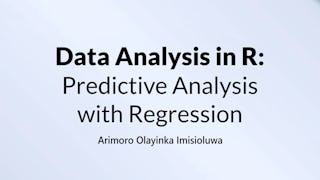Learn how to move from exploring data to modeling it with confidence. In this course, you’ll build and interpret linear and logistic regression models in R to uncover relationships, make predictions, and quantify uncertainty.



Data Modeling and Prediction with R


Instructors: Mine Çetinkaya-Rundel
Access provided by The University of Hong Kong
What you'll learn
Fit and interpret linear and logistic regression models to examine relationships between predictors and outcomes.
Evaluate model performance and recognize limitations such as overfitting.
Apply bootstrapping and hypothesis testing to quantify and communicate uncertainty in model results.
Skills you'll gain
Details to know

Add to your LinkedIn profile
4 assignments
October 2025
See how employees at top companies are mastering in-demand skills

There are 4 modules in this course
In this module, you will learn how to describe relationships between variables using simple linear regression. You’ll practice fitting models, interpreting coefficients, and visualizing patterns to uncover meaningful insights from data. By the end of this module, you’ll know how to make predictions and identify when your model might not fit as well as you think.
What's included
6 videos7 readings1 assignment1 plugin
Real-world data is rarely simple. In this module, you’ll extend regression modeling to include multiple predictors and interaction effects. You’ll explore how adding variables improves model accuracy, how to interpret complex relationships, and how to avoid overfitting as your models become more sophisticated.
What's included
3 videos4 readings1 assignment1 plugin
Not all outcomes are numerical. In this module, you’ll learn how to model categorical outcomes (e.g., “yes/no” or “spam/not spam”) using logistic regression. You’ll discover how to calculate probabilities, classify outcomes, and assess the performance of your models. Along the way, you’ll explore how overfitting affects classification and reflect on how to interpret and communicate model predictions responsibly.
What's included
5 videos6 readings1 assignment1 plugin
Every model comes with uncertainty and understanding and communicating that uncertainty is what makes you a thoughtful data scientist. In this final module, you’ll explore bootstrapping and randomization methods to measure confidence in your results, conduct hypothesis tests, and communicate findings transparently. By the end, you’ll bring together your modeling and inference skills to draw clear, data-driven conclusions.
What's included
4 videos5 readings1 assignment1 plugin
Offered by
Why people choose Coursera for their career




Explore more from Data Science

Johns Hopkins University




